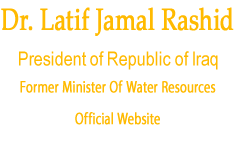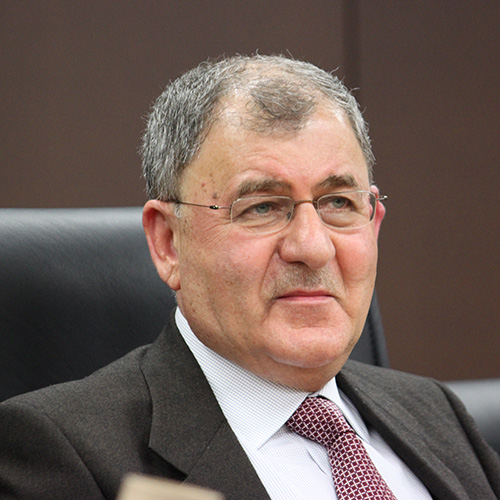By: Dr. Latif Jamal Rashid
Senior Advisor to the President
Former Minister of Water Resources
Republic of Iraq
July 2016
Water Resources Strategies
- Overview
- Issues
- Priorities and future development
- Water Resources Development Strategies
Introduction
The world is developing in different fields and this development consumes several resources, among these resources, water, and the most precious. Therefore countries started to think of diversifying water recourses and exploit it as much as it is possible in different ways. The member states of the UN expressed that during the 2012 decision regarding the right of human to access water and sanitation.
The studies that were discussed in the UN halls cleared that (884) million person lacks safe drinking water and more than (2.6) million person don’t get basic sanitation services and (1.5) million children below 5 dies of disease caused by poor quality of both water and sanitation. The decision included that (the right to access safe and clean drinking water and good sanitation is one of the human rights and it is a necessity to enjoy his full rights).
The abundance of water resources considered a main factor of stability and equilibrium in arid areas which represents a large proportion of Tigris and Euphrates basins area. And as it is known , Iraq shares it's rivers with its neighbor countries, the Euphrates river takes about 88% of its water from Turkey and 9% from Syria and
about 3% from inside Iraq . The Tigris River takes 56% of its water from Turkey and 12% from Iran and about 32% from inside Iraq.
Ancient Iraq- Water Civilization
55. If anyone open his ditches to water his crop, but is careless, and the water flood the field of his neighbor, then he shall pay his neighbor corn for his loss. Code of Hamurabi
Ancient Hydraulic Civilization
- Iridu Civilization (south of Nassirriya) 5000 BC- first evidence of irrigation systems.
- Sumeria-Akkadia-Ur 4000-3000 B.C.
I-tu-rungal Canal ( Baghdad to Nassirriya)
- Babylonia/Hammurabi 1900-1600 B.C. Nimrud Dam on the Tigris, other dams.
- Assyrian Age 1600-700 B.C. Sennacherib’s Canals, dams in Nineveh.
- Chaldean Age 700-600 B.C. Nebuchadnezzar’s dams and reservoirs.
- Persian, Greek, Parthian Age 600 BC – 637 AD.
- The Great Flood of 627-628 AD (created marsh system).
Water Resources Management
1- The Water Resources authorities (MoWR) provide Integrated Water Resource Management to the citizens of Iraq. As the steward of this vital resource.
2- The authorities have strive to balance the competing demands of irrigation, municipal and industrial water supply, hydropower, flood control, and environmental requirements, including marsh restoration. It involves to manage groundwater resources and supplies water to rural customers.
Background
- The bulk water supplier for the Nation of nearly 30 million people.
- Operate 25 major dams & barrages and 275 irrigation pump stations.
- Produce 20 % of Iraq’s electricity.
- Maintain irrigation & Drainage channels.
- Irrigate 3.25 million hectares.
- Total length of networks (irrigation and drainage) = 126887 km.
Background Continue
- About 3/4 of Iraq`s water comes from Turkey.
- 70% of flow occurs during flood season lasting 4 months ending in May.
- All reservoirs designed for carry-over storage.
- Groundwater used for domestic needs and irrigation in Kurdistan.
- Over 100 water control structures.
Flows in Iraqi Rivers
160 BCM (wet year)1969
28.16 BCM (dry year) in 1999 and 2001
76.88 BCM {(Average year) 1930-1990}
Balancing Competing Demands:
Flood control
Irrigation
Municipal and Industrial Water Supply
Environmental requirements including marsh restoration
Hydropower
Storage Capacity (BCM)
Mosul = 13.14 BCM
Dokan = 7.80 BCM
Derbendi-khan = 3.80 BCM
Hemrin = 3.76 BCM
Al-Adhaim = 4.00 BCM
Haditha = 10.00 BCM
Tharthar = 85.00 BCM
Agriculture (87-90% of water use)
- Land suitable for Agriculture =11.11 Mill. Hectare.
- Lands technically and economically suitable for Irrigation=5.72 Mill. Hectare.
- Agriculture provides 9% of GDP (Was 16% in 1968). Estimated at $US 1.6 billion in 2002.
- Employs 20% of population.
- Support all rural population 27% of population.
- 60% of family income used to be spent on food before implementing the Ration Card.
Future Directions in Water Resources Development Projects
1- Rehabilitation, Construction and O &M of pumping stations across the country Includes:
- Rehabilitation or replacing pumps,
- Electrical power
- Generators
- National grid
- Fuel supply
- Operation and maintenance
2- Land Reclamation Projects
Includes:
- Construction of new projects
- Complete the remaining phases of the existing projects
- Rehabilitation of the irrigation and drainage networks
- Construction of field drains networks
- Canal lining
- Canal dredging
- Connection of the drainage network to the Main Outfall Drain (M.O.D)
- The use of modern irrigation technologies to improve water use efficiency (drip & sprinkler systems)
3- Restoration of Iraqi marshlands
Includes:
- Restoration of the marshes to the maximum possible extent
- Building infrastructure and basic services
- Providing environmental monitoring
- Quantity & quality of Water
- Biodiversity
- Sustainability
- Supporting traditional industries and local economy.
4- Build, rehabilitation, operate and maintain dams, reservoirs, barrages and regulators.
Includes:
- Rehabilitation, O&M of storages and hydraulic control structures (9 major dams, 18 barrages and tens of regulators)
- Dredging and cleaning of major rivers, canals and drains (about 55.00 thousand km long)
- Building new dams
- (in Kurdistan, northern and western Iraq).
5- Hydropower generation
- Rehabilitation, operate and maintain the hydro power generation system (total design capacity is 2465 MW),
- at present gives about 17% to 20% of national capacity.
Investment needs in the Water Resources Sector
It is estimated the financial resources needed as follows:
- $13.5 billion for land reclamation projects
- $3.44 billion for Water resources development and eco-restoration in the South
- $12 billion for dams and reservoirs.
Activities Related to Resources in Iraq (Role and functions)
- Nation’s water management and the supply of bulk water for agriculture, industry and potable water.
- In charge of storing, managing and planning Iraqi water resources across the country.
- Development of irrigation and drainage systems
- Construction of dams, canals, regulators, barrages, pumping station and irrigation/drainage systems;
- Operation & maintenance of all water-related civil structures.
- Determination of water allocation and supplies for various users.
- Management of water in rivers, streams, reservoirs, marshes and the groundwater. - Assessment of water resources.
- Issuing water extraction licenses.
- Funding research and studies on land and water.
- Monitoring, planning and managing water use. Across the country.
-Protecting the environment, biological diversity and related ecosystems.
- Restoring the Marshlands.
- Negotiating water sharing agreement with other riparian countries- Especially; Turkey, Iran and Syria. To achieve agreeable and just arrangement for sharing water. To agree on operational procedure of dams and reservoirs. To cover the required amount for domestic and agriculture, etc.


